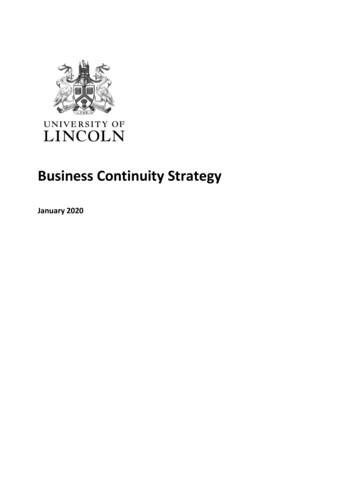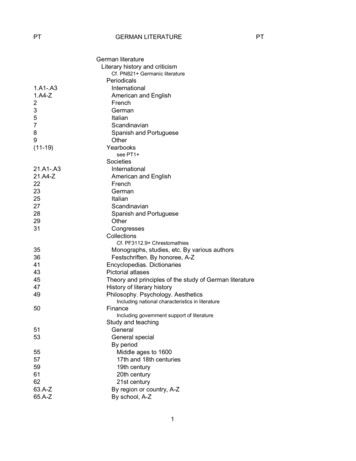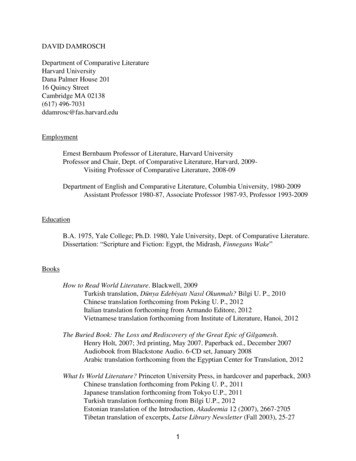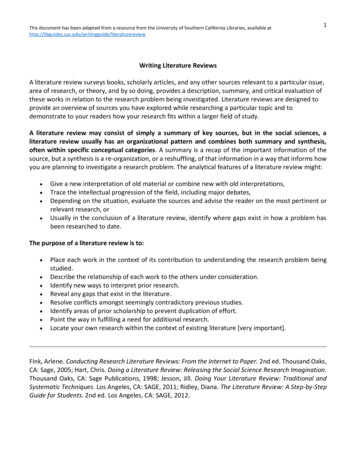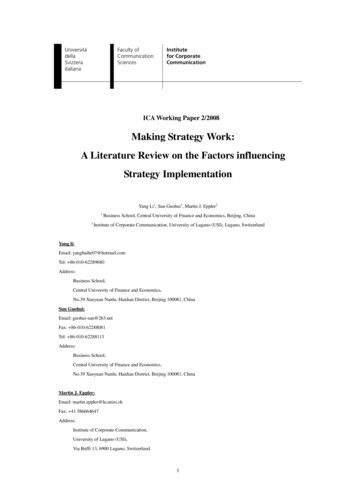
Transcription
ICA Working Paper 2/2008Making Strategy Work:A Literature Review on the Factors influencingStrategy ImplementationYang Li1, Sun Guohui1, Martin J. Eppler212Business School, Central University of Finance and Economics, Beijing, ChinaInstitute of Corporate Communication, University of Lugano (USI), Lugano, SwitzerlandYang li:Email: yangbaihe07@hotmail.comTel: 86-010-62289680Address:Business School,Central University of Finance and Economics,No.39 Xueyuan Nanlu, Haidian District, Beijing 100081, ChinaSun Guohui:Email: guohui-sun@263.netFax: 86-010-62288081Tel: 86-010-62288113Address:Business School,Central University of Finance and Economics,No.39 Xueyuan Nanlu, Haidian District, Beijing 100081, ChinaMartin J. Eppler:Email: martin.eppler@lu.unisi.chFax: 41 586664647Address:Institute of Corporate Communication,University of Lugano (USI),Via Buffi 13, 6900 Lugano, Switzerland.1
Making Strategy Work: A Literature Review on the FactorsInfluencing Strategy ImplementationAbstractAlthough numerous studies acknowledge that strategies frequently fail not because of inadequatestrategy formulation, but because of insufficient implementation, strategy implementation has receivedless research attention than strategy formulation. In this study, we review the factors that enable orimpede effective strategy implementation, and survey the state-of-the-art in this domain. We highlighthow strategy implementation has been researched so far – and in which contexts – and how this fieldmay be moved forward. As a result of our literature analysis, spanning the last twenty-four years, wefind nine crucial factors for strategy implementation that are frequently discussed in the literature aswell as two approaches of aggregating and relating relevant factors. We find several important researchneeds regarding these factors and outline how they could be addressed.KeywordsImplementation factors, implementation phases, strategy communication, strategy implementation,strategy execution, strategic managementAcknowledgementThe China Scholarship Council provided financial support for this study.2
1. IntroductionAlthough formulating a consistent strategy is a difficult task for anymanagement team, making that strategy work – implementing it throughout theorganization – is even more difficult (Hrebiniak, 2006). A myriad of factors canpotentially affect the process by which strategic plans are turned into organizationalaction. Unlike strategy formulation, strategy implementation is often seen assomething of a craft, rather than a science, and its research history has previouslybeen described as fragmented and eclectic (Noble, 1999b). It is thus not surprisingthat, after a comprehensive strategy or single strategic decision has been formulated,significant difficulties usually arise during the subsequent implementation process.The best-formulated strategies may fail to produce superior performance for the firmif they are not successfully implemented, as Noble (1999b) notes. Results fromseveral surveys have confirmed this view: An Economist survey found that adiscouraging 57 percent of firms were unsuccessful at executing strategic initiativesover the past three years, according to a survey of 276 senior operating executives in2004 (Allio, 2005). According to the White Paper of Strategy Implementation ofChinese Corporations in 2006, strategy implementation has become “the mostsignificant management challenge which all kinds of corporations face at themoment”. The survey reported in that white paper indicates that 83 percent of thesurveyed companies failed to implement their strategy smoothly, and only 17 percentfelt that they had a consistent strategy implementation process.It is thus obvious that strategy implementation is a key challenge for today‟sorganizations. There are many (soft, hard and mixed) factors that influence thesuccess of strategy implementation, ranging from the people who communicate orimplement the strategy to the systems or mechanisms in place for co-ordination andcontrol. How can we better understand these issues and their importance forsuccessful strategy implementation? In this article, we try to respond to this questionby analyzing existing research on the factors that influence strategy implementation.We have conducted an analysis in the most widely used literature databases to identifykey factors influencing the process of strategy implementation, to surface currentareas of agreement and disagreement, as well as missing evidence and resulting futureresearch needs. Our study also examines the ways in which strategy implementationhas been researched so far, in terms of the applied research methods and the examinedstrategy contexts. It will consequently also reveal under-exploited methods orcontexts.The structure of this paper is as follows: First, we analyze definitions ofstrategy implementation and compare them with other synonymous and related terms3
(in section 2). Then, we describe the methodology that we have used to conduct ourliterature review and define its scope (section 3). The next part of the article, section 4,contains the actual review of literature, focusing on the main results of prior studies.In that section we present a discussion of nine major factors that affect strategyimplementation. Section four also contains a review of existing models andframeworks of strategy implementation. In the fifth section of the article, we discussthe implications of our findings as well as their limitations. We present a conceptualframework that organizes the current research findings. We also discuss directions forfuture research in the domain of strategy implementation and how they may bepursued. In the sixth and final section, we discuss the limitations of our own approachand summarize open research questions regarding strategy implementation that havesurfaced at various points in our literature analysis.2. Definitions of Strategy ImplementationThere is little controversy regarding the labeling of the strategyimplementation topic in the sixty articles that we have reviewed. Sashittal & Wilemon(1996) have pointed out that some terms synonymous with “implementation”, such as“execution”, and “actualization of goals” are often employed in the managementliterature, but are not frequently used by managers themselves.As far as the terms „execution‟ or „executing‟ in the strategy context areconcerned, most of the 60 articles in our literature review, use strategyimplementation as a key word or as a part of the title and only very few use the termstrategy execution. There are no articles differentiating strategy implementation fromstrategy execution in the 60 articles that we have reviewed, while some authors takestrategy execution as an exact synonym of strategy implementation. Hrebiniak (2006)notes for example: “Formulating strategy is difficult. Making strategy work –executing or implementing it throughout the organization – is even more difficult”.Thompson & Strickland (2003) have stressed that the strategy-implementing /strategy-executing task is the most complicated and time-consuming part of strategicmanagement (cited in Schaap, 2006). Consequently, we will not distinguish strategyimplementation from execution. We will use the former term as the descriptivedomain label, as it is more widely used in the relevant literature.There is no universally accepted definition of “strategy implementation”.Nevertheless, we have been able to identify three distinct conceptions of the term: Thefirst approach concentrates on a process perspective and takes strategyimplementation as a sequence of carefully planned consecutive steps. The secondapproach treats strategy implementation as a series of more or less concerted (but4
often parallel) actions and examines these actions from a behavior perspective. Someauthors combine the process perspective and behavior or action perspective and forma third approach, which we label as a hybrid perspective (see Table I).PerspectiveDefinitionsImplementation is the process that turns plans into action assignments and ensuresthat such assignments are executed in a manner that accomplishes the plan‟sstated objectives. Kotler (1984) cited in Noble (1999b).Implementation was found to be a highly complex and interactive process withmany variables impinging upon it – more of a „spring‟ than a simple cascade.ProcessperspectiveMany factors influence the flow and content of the „spring‟ (Wernham, 1985).Strategy implementation is also portrayed as a lively process by which companiesidentify future opportunities. Reid (1989) cited in Schaap (2006).Strategy implementation may be viewed as a process inducing various forms oforganizational learning, because both environmental threats and strategicresponses are a prime trigger for organizational learning processes (Lehner, 2004).Implementation is a process that takes longer than formulation (Hrebiniak, 2006).Strategy implementation is an iterative process of implementing strategies, policies,programs and action plans that allows a firm to utilize its resources to takeadvantage of opportunities in the competitive environment (Harrington, 2006).It is a series of decisions and resultant actions which commit resources to achievingintended outcomes. Grinyer & Spender (1979) cited in Wernham (1985).Implementation is a series of interventions concerning organizational structures, keypersonnel actions, and control systems designed to control performance withrespect to desired ends. Hrebiniak & Joyce (1984) cited in Noble (1999b).Implementation designates the managerial interventions that align organizationalBehavioraction with strategic intention. Floyd & Wooldridge (1992a) cited in Nobleperspective(1999b).Implementation is the actions initiated within the organization and its relationshipswith external constituencies to realize the strategy. Varadarajan(1999) cited inHomburg & Krohmer & Workman (2004).Implementation is a hands-on operation and action-oriented human behavioralactivity that calls for executive leadership and key managerial skills. Dekluyver& Pearce (2003) cited in Schaap (2006).Implementation is operationally defined as those senior-level leadership behaviorsand activities that will transform a working plan into a concrete reality (Schaap,2006).Implementation is defined as “ the sum total of the activities and choices required5
for the execution of a strategic plan the process by which strategies and policiesare put into action.” Wheelen & Hunger (1992) cited in Smith & Kofron (1996).In the instances where plans, strategies, technologies, or programs are markedly newHybridto the firm, implementation appears to involve organizational designperspectivereconfiguration - i.e., a redesign of structure, systems, process, people, andrewards. Galbraith & Kazanjian (1988) cited in Sashittal & Wilemon (1996).In other instances, implementation is viewed as an action-oriented process thatrequires administration and control. Govindarajan (1988) cited in Sashittal &Wilemon (1996).Strategy execution is defined as the step-by-step implementation of the variousactivities that make up a formulated decision-making strategy. Strategy executionalso can be treated as a cognitive process (Singh, 1998).Table 1: Definitions of strategy implementationAmidst the relative uniformity of the definitions compiled in table I, it isinteresting to note that several definitions stress the role of top management (such asSchaap 2006 and other researchers cited there). Only a few definitions stress theexternal environment (such as Lehner, 2004, and Harrington, 2006). Surprisingly, nota single definition mentions the (non-managerial) employees and their crucial role inturning strategic plans into results.Taking these prior definitions and considerations into account, we candefine strategy implementation as a dynamic, iterative and complex process, which iscomprised of a series of decisions and activities by managers and employees –affected by a number of interrelated internal and external factors – to turn strategicplans into reality in order to achieve strategic objectives.3. MethodologyIn order to identify the factors that enable or impede effective strategyimplementation, we have analyzed relevant academic, peer reviewed journals (such asthe Strategic Management Journal (ten articles), the Academy of Management Journal(five articles), the Journal of Management Studies (four articles), Long RangePlanning, Journal of Management, Academy of Management Executive, HumanRelations, Sloan Management Review, Journal of Marketing, etc.) using the literaturedatabases of EBSCOhost, ProQuest ABI, Sciencedirect, JSTOR and WileyInterscience.We have used the following selection criteria to choose articles for inclusionin our analysis: First, we have selected articles which contain the keywords “strategy6
implementation” or “strategy execution” or where the title includes one of thesecompound terms. From this, we have continued to identify further articles using thereferences sections of the previously retrieved articles. In this way, we have alsoincluded articles which treat strategy implementation as one of the major subjectseven if their title or keywords did not include the terms strategy implementation orstrategy execution. As a final selection criterion we have checked whether the articlesexplicitly discuss factors impeding or enabling strategy implementation success.Based on the above criteria, we have selected 60 articles for inclusion in ourreview. Almost all of these (54 articles) are long research papers (i.e., longer than 10pages), published in top journals in the fields of strategic management, organizationstudies, marketing (with regard to the implementation of marketing strategy) ormanagement. In terms of time span, we have focused on articles from the lasttwenty-four years (in order to include also older seminal papers on the topic). Theearliest article in our sample has been published in 1984, while the latest one is from2007. More specifically, there are 13 papers from the 1980s‟, 23 papers from 1990s‟,and 24 papers from 2000 to 2007. There thus seems to be an increasing trendregarding the number of published studies in every period.4. Literature ReviewIn this section, we will review the 60 identified studies and analyze theirresearch context, their main results, theoretical bases, the research methods used aswell as the analytical techniques employed. Examined organizational levels andorganizational types are two elements of the research context. As the core of ourliterature review, the results section compiles nine factors that influence strategyimplementation success, as well as several frameworks or models that aggregate orrelate relevant factors to each other. We then briefly discuss the theoretical bases ofthe reviewed studies. Finally, the research methods and analytical techniques will bereviewed to see which methods are still underutilized in the context of strategyimplementation.4.1 Research ContextsWe classify research contexts into two dimensions: the examinedorganizational levels and the considered organizational types. Organizational levelsdesignate the locus of strategizing, i.e., whether a study focuses on functionalstrategies (i.e., marketing, HR, R&D), SBU-level strategies or corporate strategies.Organizational types refer to the kind of organization that is studied, i.e., whether it isprivately held or state-owned and whether its operating scope is regional or rathermultinational.7
Organizational LevelsIn the context of strategy implementation research, five organizationallevels can be distinguished. They are: corporate level, strategic business unit (SBU)level, functional level, operational level and mixed levels (such as corporate and SBUlevel, SBU and functional level, inter-functional levels, corporate-SBU-functionallevels, etc.).Surprisingly few researchers focus on the implementation of corporate levelstrategies, such as Wernham (1985) and Schmidt & Brauer (2006), while manyexamine SBU level strategies (Gupta & Govindarajan, 1984; White, 1986;Govindarajan, 1988; Govindarajan, 1989; Govindarajan & Fisher, 1990; Skivington &Daft, 1991; Roth & Schweiger & Morrison, 1991; Floyd & Wooldridge, 1992b;Waldersee & Sheather, 1996; Nilsson & Rapp, 1999; Chimhanzi & Morgan, 2005;Olson & Slater & Hult, 2005; Schaap, 2006; Brenes & Mena & Molina, 2007). Thesame holds true for functional strategies: We have found eight studies that focus onthe implementation of such strategies, namely Rapert & Lynch & Suter (1996),Sashittal & Wilemon (1996), Piercy (1998), Noble (1999a), Noble & Mokwa (1999),Chimhanzi (2004), Qi (2005), Viseras & Baines & Sweeney (2005). Most of thesestudies, however, focus on marketing strategy (such as Sashittal & Wilemon, 1996;Piercy, 1998; Noble & Mokwa, 1999, Chimhanzi, 2004). There are few studiesdedicated to the implementation of other functional strategies (this is clearly an areaof future research). The only other study of functional strategy implementation thatwe have been able to identify is Viseras, Baines and Sweeney‟s study (2005) in thecontext of manufacturing strategies. This study focuses on the key success factors inthe project management for the implementation of strategic manufacturing initiatives.Few studies focus on the actual operational level of strategy implementation,such as Bantel (1997), Homburg & Krohmer & Workman (2004). Bantel (1997)analyzes the effects of two key aspects of product strategy (product leadership andproduct/market focus) on performance, and on two aspects of strategicimplementation (stakeholder input and employee empowerment). This study alsoemphasizes the relationship between product strategy and several strategicimplementation variables. Homburg, Krohmer & Workman (2004) point out thatmarket orientation plays a key role for the successful implementation of a PPD(premium product differentiation) strategy.There are some studies which cannot be classified into the above categories.Consequently, we classify them into a group called mixed level studies: Gupta (1987),Beer & Eisenstat (2000) and Hrebiniak (2006) have carried out research on corporateand SBU-level strategy. Walker and Ruekert (1987) analyze three levels of strategy –8
corporate, SBU and functional. Higgins (2005) even focuses on four types ofstrategies: corporate, business, functional and process. Process strategies, the last type,normally cut across functions and are aimed at integrating organizational processesacross the organization in order to make them more effective and more efficient.Slater and Olson (2001) analyze marketing‟s contribution to the implementation ofbusiness strategy. The mixed studies category also includes articles that focus on therole of project management for strategy implementation. Okumus (2001), for example,focuses on the implementation of a yield management project and a key clientmanagement project in two hotels. Peng and Litteljohn (2001) investigate three hotelchains implementing a strategic initiative on yield management. Grundy (1998)examines the synergies among project management and strategy implementation andreviews strategy tools that may help in project management.Finally, there are many studies that are not sufficiently explicit regardingtheir scope concerning strategic levels. Examples of such ambiguous studies areBourgeois Ш and Brodwin (1984), Nutt (1986, 1987, 1989), Noble (1999b), Lehner(2004), Higgins (2005), Harrington (2006), and Schaap (2006).We can draw multiple conclusions based on our analysis of the treatment oforganizational levels in prior studies of strategy implementation. We note that –among the five strategy levels – the SBU-level (14 articles), the functional- level (8articles) and mixed levels (9 articles) have received more attention than the other twolevels, corporate (2 articles) and operational (2 articles). Many studies (25 articles) donot even indicate at which level their discussion of strategy implementation is located.Two calls to action result from these findings. First, the implementation ofcorporate strategies is an under-researched area (perhaps with the exception ofpost-merger integration research that we have excluded in our review) and should begiven more research attention. Second, future strategy implementation researchshould pay attention to explicitly indicate the level of analysis. Within the functionallevel, another finding revealed that marketing is the prevailing domain, comparedwith other functional areas (such as manufacturing, R&D, HR, accounting etc.). Interms of promising future research on strategy implementation, we can observe thatthere are very few studies that have examined the inter-relationships of functional andbusiness strategies. One such study focuses on marketing‟s contribution to theimplementation of business strategy (Slater & Olson, 2001). Another study hasexamined the mutual influence of functional departments‟ relationships on strategies,which seems a highly relevant area to improve our understanding of strategyimplementation: Chimhanzi (2004) has examined the impact of marketing and HR9
interactions on marketing strategy implementation.Organizational typesOrganizational types, as stated earlier, refer to the characteristics oforganizations: if they are private or state-owned, local or multinational.As far as ownership forms are concerned, strategy implementation studiesdiscuss both, state-owned and privately held companies. Wernham (1985), forexample, explores the reality of strategy implementation in a U.K. nationalizedcompany, British Telecom (BT). Alexander (1985) surveys 93 private sector firmsthrough a questionnaire. Qi (2005) issues questionnaires to the head offices of 800private companies in the UK. Noble‟s (1999a) study spans several types oforganizations – a national airline, a major financial services firm, a leading packagedgoods company, a provider of emergency fire and medical services, and a leadingfirm in the imaging technology industry. Some of the researched companies focus ontheir domestic markets, while others are multinational corporations. Rapert,Velliquette and Garretson‟s (2002) study on strategy implementation takes anationwide sample of 1000 CEOs of general service hospitals, which are members ofthe American Hospital Association (AHA); Roth & Schweiger & Morrison (1991)and Kim & Mauborgne (1991, 1993) study global strategy; Okumus (2001)investigates two international hotel groups; Forman and Argenti (2005) select fivemultinational companies as samples, namely Accenture, Dell, FedEx, Johnson &Johnson, Sears.In conclusion, the subjects of strategy implementation studies are not onlystate-owned corporations, but mostly private corporations, not only local firms butalso multinational firms. However, there have been no studies comparing similaritiesand differences of strategy implementation among private corporations andstate-owned corporations, or among local firms and multinational firms. We thus donot know which specific differences exist regarding strategy implementation in thesevarious forms organizations. This clearly is another interesting avenue for futureresearch.4.2. Research ResultsIn our review of existing studies, we have found two types of strategyimplementation studies: those highlighting the importance of individual factors forstrategy implementation and those that emphasize the „big picture‟ of how suchfactors interrelate and form a strategic implementation environment. In the firststream of research we have identified nine recurring, individual factors that influencestrategy implementation. They are: the strategy formulation process, the strategy10
executors (managers, employees), the organizational structure, the communicationactivities, the level of commitment for the strategy, the consensus regarding thestrategy, the relationships among different units/departments and different strategylevels, the employed implementation tactics, and the administrative system in place.The second stream of research analyzes multiple factors together within a single(arguably comprehensive) framework or a model. Below, we first summarize thediscourse on the nine individual factors and their impact on strategy implementationand then discuss the integrated frameworks and models.4.2.1 Studies Focusing on Single FactorsBelow we will summarize the research results regarding nine differentfactors that affect strategy implementation. These nine factors can be divided into soft,hard, and mixed factors. Soft factors (or people-oriented factors) include the people orexecutors of the strategy, the communication activities (incl. content and style issues)as well as the closely related implementation tactics, the consensus about andcommitment to the strategy, while the hard (or institutional) factors include theorganizational structure, the administrative systems. The way in which the strategywas developed and articulated (strategy formulation) contains hard and soft factorsalike and is thus considered a mixed factor. Relationships among differentunits/departments and different strategy levels also is treated as a mixed factor. In thefollowing paragraphs we first discuss the mixed factors, then the soft factors, andfinally the hard factors affecting strategy implementation.I. Strategy formulationIt is clear that a poor or vague strategy can limit implementation effortsdramatically. Good execution cannot overcome the shortcomings of a bad strategy ora poor strategic planning effort (Hrebiniak, 2006). Several studies mention the factthat the kind of strategy that is developed (Alexander, 1985; Allio, 2005) and theactual process of strategy formulation, namely, how a strategy is developed (Kim &Mauborgne, 1991, 1993; Singh, 1998) will influence the effect of implementation.Alexander (1985) believes that the need to start with a formulated strategy thatinvolves a good idea or concept is mentioned most often in helping promotesuccessful implementation. As Allio notes, good implementation naturally starts withgood strategic input: the soup is only as good as the ingredients (Allio, 2005).Whether a strategy itself is consistent and fitting or not is a key question forsuccessful strategy implementation, but even a consistent strategy cannot be all thingsto all people. Bantel (1997) suggests that particular product/market strategies areeffective at achieving particular performance goals to the exclusion of others. One ofhis conclusions is that synergies between strategy types and implementation11
capabilities exist and should be exploited.The central conclusion of the research of Kim & Mauborgne (1991) is thatthe procedural justice of the strategy formulation process ultimately affects thecommitment, trust, and social harmony as well as the outcome satisfaction ofmanagers in subsidiaries. Procedural justice provides a potentially useful but stillunexplored way to mobilize a multinational‟s global network of subsidiaries. Kim &Mauborgne (1993) point out that a subsidiary‟s top managers want an open process,that is consistent and fair, and that allows for their input to be heard. In the presenceof a so-called due (or open) process, subsidiary managers are motivated to implementglobal strategies. They feel a strong sense of organizational commitment, trust in headoffice management, and social harmony with their head office counterparts. In theabsence of such a due and fair process, the effect may be the opposite from theintended one (ibid).Singh (1998) discusses the specific cognitive requirements of the strategyimplementation process and how they can be met with the help of software-baseddecision tools. The results indicate that computerized cognitive aids can successfullybe designed into decision support systems (DSS) to support decision makers‟ strategyexecution process and that such aids have a significant positive impact on bothdecision-making efficiency and effectiveness. In general, however, we can observethat the topic of DSS is much more strongly rooted in strategy formulation than instrategy implementation.II.Relationships among different units/departments and different strategy levelsSeveral studies treat institutional relationships among different units/departments and different strategy levels as a significant factor that affects theoutcome of strategy implementation (Walker & Ruekert, 1987; Gupta, 1987; Slater &Olson, 2001; Chimhanzi, 2004; Chimhanzi & Morgan, 2005). Walker & Ruekert(1987) divide business strategy behaviors into three types: prospectors, differentiateddefenders and low cost defenders. These distinctions are based on the strategycategories introduced by Miles & Snow (1978; prospectors, defenders, analyzers,reactors) and by Porter (1980; overall cost leadership, differentiation and focus).Walker & Ruekert stipulate that corporate-business unit relationships, inter-functionalstructures and processes, marketing policies and processes may all significantlyinfluence business strategy implementation. Three aspects of the corporate-businessunit relationship are especially likely to affect a unit‟s success in implementing aparticular strategy: business unit autonomy, sharing programs and synergies acrossSBUs, as well as control and reward systems. In addition, functional competencies,allocation of resources, decision-making participation and influence, inter-functionalconflict and coordination may have vastly different effects on the implementation of12
different kinds of strategies. Walker and Ruekert also assume that decision-makingand coordination structures in the marketing department, and marketing policies andprograms within the business unit, affect the performance of different businessstrategies in different ways.Gupta (1987) classifies SBU‟s strategic contexts into two dimensions:strategic mission (such as a „build‟ strategic mission and a „harvest‟ strategic mission)and compet
1 ICA Working Paper 2/2008 Making Strategy Work: A Literature Review on the Factors influencing Strategy Implementation Yang Li 1, Sun Guohui , Martin J. Eppler2 1 Business School, Central University of Finance and Economics, Beijing, China 2 Institute of Corporate Communication, University of Lugano (USI), Lugano, Switzerland Yang li: Email: yangbaihe07@hotmail.com


